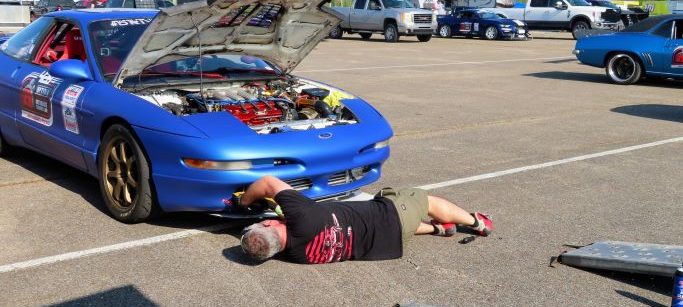We’ve been busy. This Probe is just about ready for its debut. In our last update we had largely completed the turbo build, but there were lots of odds and ends to deal with after that.
Prior to buttoning up the front end of the car, for instance, we had to do some body and fender work on the nose. Twenty seven years had left a few marks, so after clearancing it for all the new crap that got mounted to the nose, I filled all the pits and holes and repainted it.
With that completed and reattached, I had to turn to the rear of the vehicle for a day. The roll bar I purchased was a four-point drag race bar, but the SCCA recently added a Hill Climb to the schedule that’s close by, and I wanted to run it. That required a diagonal brace get added to the cage to stabilize it laterally. $26 in tube from Metal Supermarket and I was in business:
With this done, and the car running pretty well, it was time to get it tuned. I got an appointment with MCR Tuning in Park City, Kentucky and loaded the car up for a little road trip. However, we couldn’t just go. We had to do some maintenance on the trailer. Well, it had some issues. Here’s one of the wheel strap ratchets:
Three days for a new set of ratchets to arrive, and I was back in business.
Getting to the shop was easy, it’s an easy 79 mile drive south, and we arrived right on time:
We quickly got the car strapped down and started doing pulls. Matthew is a master tuner, though his usual fare is LSx based GM stuff making big power numbers. Something as quaint and delicate as a 2.5L boosted Probe is a novelty for him.
The TLDR: It worked.
My stock Probe was making ~140 horsepower at the wheels. I know this because I know how much it weighs, and I have data logs that tell me how quickly it could accelerate on level ground. After that it’s just math.
The first pull with the turbo and a tune I roughed in after some street driving was 165 horsepower.
Six or seven pulls later, we realized the boost controller wasn’t working. Some hacks to the wiring and a switch from closed loop boost control to open loop and we were in business. The next pull it laid down 180 horsepower before popping a charge pipe.
Once I got the charge pipe cinched back down, a few more pulls to finalize the fueling and clean up the timing map and we had 210.65 to the wheels. Assuming 15% drivetrain loss, that’s 250 horsies at the crank. Very good for a 27 year old car with 267,000 miles on the engine.

Now, MCR’s dyno’s RPM pickup wasn’t working, so the data we got was power versus speed. No problem, so math can back out the MPH the dyno saw and turn it directly into engine RPM, and from the engine RPM and measured horsepower, we can derive torque.
210.65 horsepower @ 5204 RPM, 244.2 lb-ft of torque at 4386 RPM. That’s a 50% increase of the 140hp stock performance. The best part? Well, look at the power curve in green. It’s as flat as a table. This thing is going to be so easy to drive. BROAD torque curve and consistent power delivery. This thing is going to be a blast this year.
Additionally, beyond the charge pipe popping out and the boost solenoid issue, and some smoke from the header wrap curing, the car performed perfectly. No leaks, no engine noises. Didn’t burn any noticeable amount of oil during the day. This thing is ready.
So, in the next few days, I’ll get the boost solenoid wiring ironed out in a more permanent way, and we will be ready for our first event, March 27 with the Columbus Sports Car Club, followed two weeks later by The Optima Search for the Ultimate Street Car event in New Orleans. Keep an eye on this space for updates, and like and follow us on Instagram, Twitter, Facebook, and Youtube!
